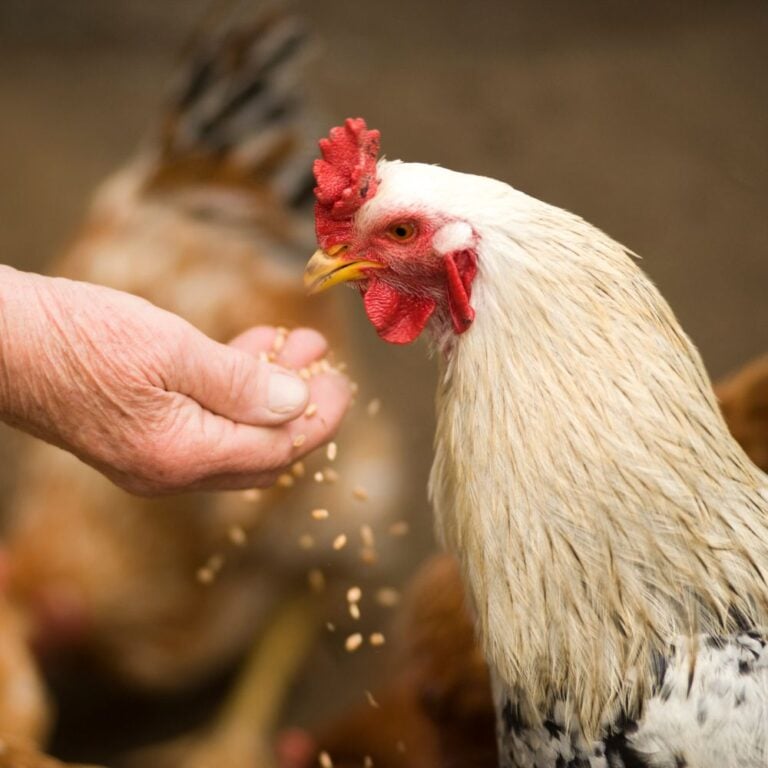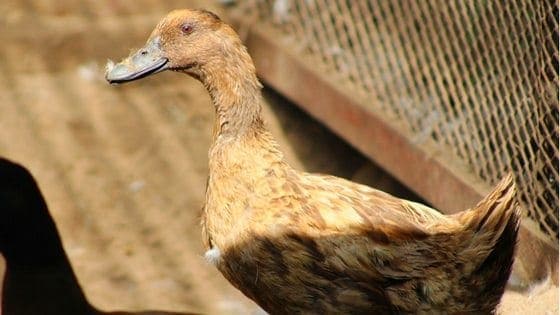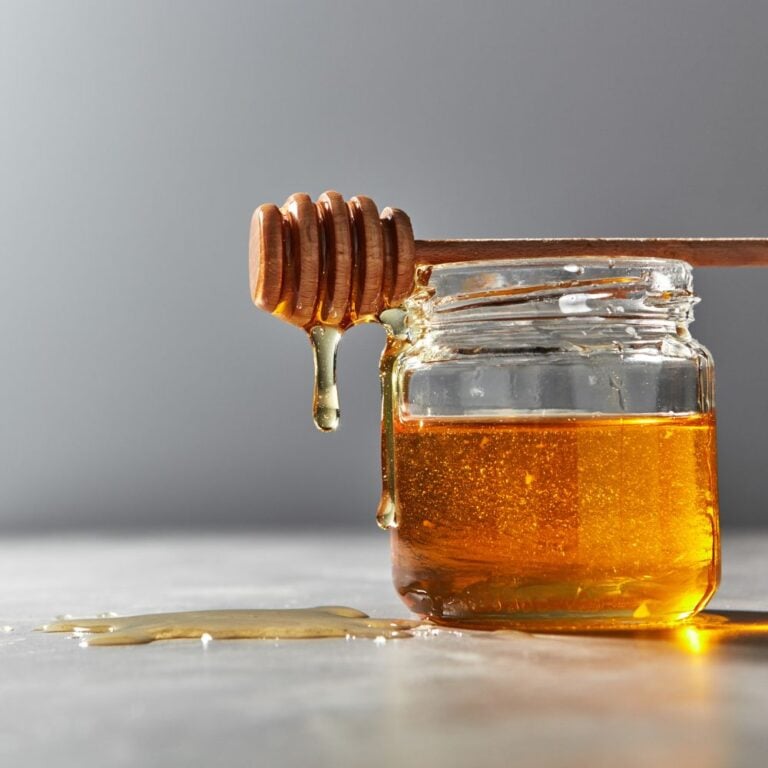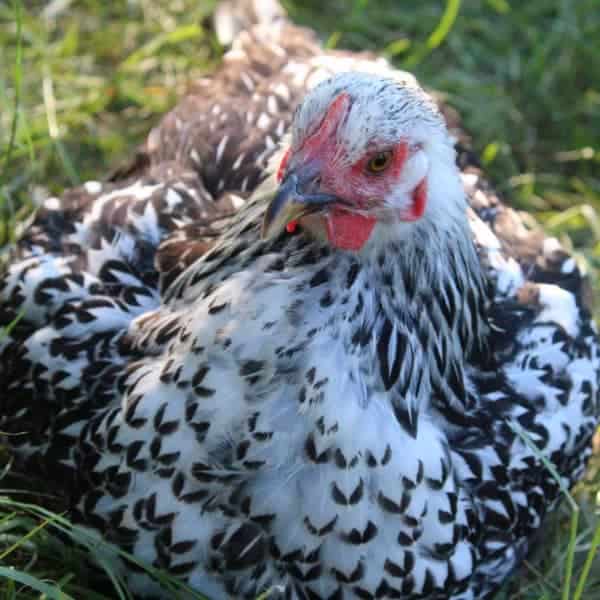Dealing with a sick chicken is never fun, but sometimes necessary. And while there are many chicken illnesses out there, there are a few whose symptoms you should know.
Although there are many diseases your chicken can develop or contract, in this article I”m going to cover the most common illnesses you need to know about, their symptoms, and how to treat them. Some are obviously more common than others, but in this article, we are going to look at common illnesses you might come across. I will also touch on an illness or two that are less common, but still important to know about.
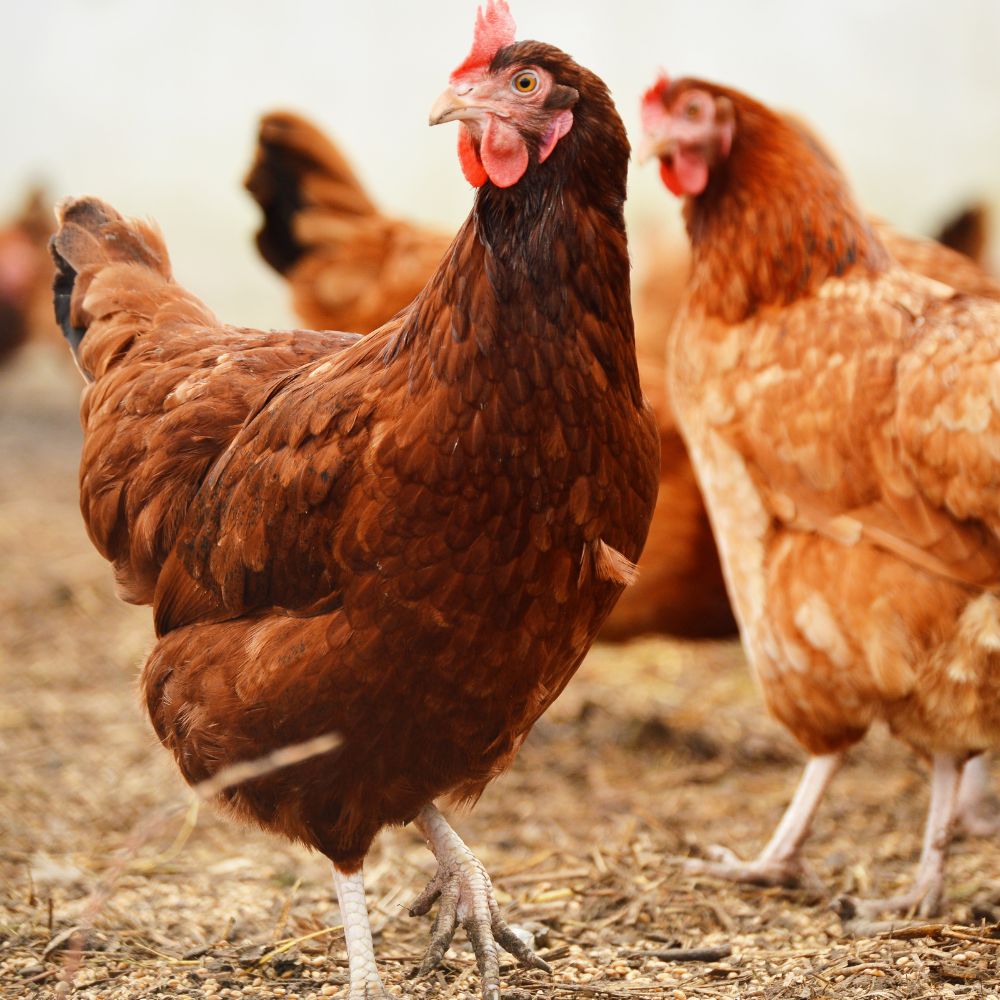
Table of Contents (Quickly Jump To Information)
Important Disclaimer
Now before we get started, I need to make a legal disclaimer, which is that the information in this article is for educational purposes only.
I am not a licensed vet, and the information is reflective of my experience only. As always, use your best judgment and seek a qualified vet’s advice if you are concerned your chicken might be sick.
Now, let’s get on with common chicken illnesses and symptoms you should know about.
Common Chicken Illnesses
Egg binding
So, first on our list is egg binding. So what is this chicken illness? Egg binding is when your chicken, for a variety of reasons, can’t pass the egg she’s trying to lay, and it gets stuck in her oviduct.
One thing to keep in mind is that egg binding can be a serious problem, and it should be treated like an emergency. It does have the capability to be fatal to your chicken.
Reasons egg binding happens can be related to infections, some sort of trauma to the reproductive tract, excessive egg laying, for example, with birds bred for a high rate of egg production, as well as nutritional problems, such as if a chicken isn’t getting enough calcium.
Other reasons for egg binding are obesity and an egg that is too soft. An egg that is too soft is another calcium issue.
It can also be an internal structure that is prone to egg binding, such as a cloaca that is too small to pass the egg.
What are some symptoms of egg binding?
One of the first symptoms you might notice is your chicken squatting a lot, with her wings dropped toward the ground. Other signs are a fluffed appearance, straining, labored breathing, and a chicken that’s not pooping or doesn’t want to eat.
If you palpate your chicken and feel an egg-shaped lump near her vent, that’s a good sign and probably a clear symptom that your hen is egg-bound.
When you suspect egg binding but don’t have definitive proof, then you can take your hen to a qualified vet for an x-ray.
If the egg has formed correctly and is fully calcified, then you will likely be able to see the egg.
How do we treat this chicken illness?
You will want to soak your chicken in a tub of warm water with Epsom salts in it.
Soak the lower part of her body, including her vent, in the Epsom salt bath for about 20 minutes. Massage her abdomen to stimulate the egg to move.
After soaking her, place her in a warm, quiet area to give her time to try to lay the egg.
Repeat this every hour until the chicken lays the egg. Be sure to offer her electrolytes in water to keep her hydrated.
If you prefer, you can take your chicken to a vet to see if the egg can be crushed and removed. This can result in infection, so my recommendation is to let a qualified vet do it.
If you can see the egg, you can attempt it yourself. I do recommend that you consult with a vet first and see what antibiotics you should put your chicken on after in order to prevent infection. If you cannot see the egg, do not attempt this.
Bumblefoot
Next on our list of chicken illnesses is bumblefoot. So what is this? Well, it’s actually a bacterial infection of your chicken’s foot.
You’ll know if your chicken has bumblefoot if you look at the bottom of the feet and you see a large lump.
Bumblefoot, also called ulcerative pododermatitis, is a bacterial infection that is caused by the Staphylococcus bacteria. So, it’s a staph infection.
It happens when your chicken gets a cut (even a microscopic cut) on its foot from walking on hard or sharp surfaces.
Some symptoms include swelling in the feet and limping
Chickens with bumblefoot might have swellings on the pad of the foot. Or the entire foot can look swollen and enlarged. It might look as simple as a slight redness to a bulbous-looking growth on the bottom of the chicken’s foot. The swellings, called “bumbles” give the infection its colloquial name.
If you take your chicken to the vet, he or she might also prescribe oral antibiotics. That’s really up to your vet to decide if the situation merits it.
Treatment
There are some natural options for bumblefoot. If you want to avoid pharmaceuticals, things such as essential oils, honey, or green clay can help. I like using Young Living’s Animal Scents ointment, which promotes healthy skin.
If you use oils, you should always dilute them with a carrier oil such as almond or coconut oil.
If you want more info on natural bumblefoot treatments you can read my article all about Bumblefoot here: Bumblefoot in Chickens. I go into more detail about Bumblefoot specifically and some treatment options you can use.
Should you do surgery to get rid of bumblefoot?
Bumblefoot is easily treated, and it includes opening the infected area to allow the pus to drain, then soaking it in a water and epsom salt bath. After, you can then apply your favorite topical antibacterial ointment and dress it with clean bandages.
Now, I’ve seen some online recommendations to perform surgery to treat bumblefoot yourself, and I would encourage you, if possible to have the vet perform the surgery instead.
Even if your vet is not a poultry vet, they are in a better position than either you or I to properly provide a local anesthetic to the affected area, and then remove the infection.
Personally, unless the situation is absolutely dire, I prefer to not perform surgeries myself at home largely because I don’t have the proper tools to anesthetize the area, and I’m not comfortable causing more pain in my chickens.
Marek’s Disease
According to the Merck Veterinary Manual, Marek’s disease is a type of avian cancer. Marek’s largely affects chickens between 12 to 25 weeks of age, although chickens outside that age range might also be affected.
The easiest symptoms of Marek’s to recognize include paralysis, such as flopping around, being unable to stand, odd-shaped pupils in their eyes, and blindness.
Tumors in nerves are what actually cause the paralysis, while tumors in your chicken’s eyes are what cause the irregularly shaped pupils and blindness.
The tumors can also be in the liver, kidneys, pancreas, stomach, lungs, and pretty much anywhere else you can imagine. They can cause the lack of coordination that you see with Marek’s.
Other symptoms of Marek’s disease are weak labored breathing and enlarged feather follicles. Later as the disease progresses, some symptoms include pale, scaly combs as well as greenish diarrhea.
How do chickens get Marek’s disease?
It’s transmitted by air between chickens, and it shows up in dander, dust, feces, and saliva. Infected birds that live will also have the virus in their blood for life and can infect other chickens.
There is no treatment for Marek’s, although chicks can be vaccinated at the hatchery. However, it’s important to note that the vaccination will prevent tumors from forming, but it does not prevent infections nor does it prevent other birds from getting the disease.
Coccidiosis
Coccidiosis is a parasitic disease of the intestinal tract of animals caused by coccidian protozoa.
There are a few different parasites that can cause a problem in your birds, but the bottom line is the disease spreads from chicken to chicken through infected feces or ingestion of infected tissue.
Your chicken might have coccidiosis and you may never know it, but the most easily recognized sign of coccidiosis is bloody droppings.
Treatment
So, to treat coccidiosis, you can provide an anticoccidial medication, rid the coop of any droppings and sanitize it, and offer your flock vitamins and a probiotic to re-establish good gut flora as they recover.
Just remember that you might have a withdrawal period with any medication you give them.
One way to prevent coccidiosis is to offer chicks a medicated chick starter which will help them build up a resistance to these parasites.
Vent Gleet
Vent Gleet is the lay term for Cloacitis, which basically means non-specific inflammation of the cloaca. ← Veterinary Definition.
In reality, what I’ve experienced is that vent gleet is usually a bacterial or fungal infection that causes irritation to the vent, and usually is accompanied by white/yellowish discharge.
Symptoms
- Feathers getting stuck or pasted to the vent
- Mild to thick discharge from the vent (there ideally should be NO discharge at all in a healthy chicken)
- A bad odor
- A decrease in egg production
- And/or a dull appearance
Now you can treat vent gleet, but I’m not going to go over it in this article because I have an entire article specifically about vent gleet and how you can treat it. So if you would like to learn how to treat vent gleet you can head over to that article. You can find the article here: Vent Gleet Identifying & Treating
Vent Prolapse
Essentially, a vent prolapse is a chicken’s insides coming out. While it is totally normal for the vent to temporarily prolapse when laying – it’s definitely NOT normal for it to stay that way!
Basically what happens is, the internal reproductive tract becomes loose and begins to protrude from the vent which makes passing poop and eggs painful for your hen, and potentially deadly.
There are a variety of different causes of vent prolapse and some different treatments you can try as well. If you want to learn more about it head on over to my article specifically about vent prolapse here: Vent Prolapse: How to Recognize & Treat Your Hen
Avian Influenza
Now the last of the chicken illnesses is Avian influenza because it has gotten a lot of press and I know some of you are concerned about it. Yes, chickens can catch avian influenza.
I have no experience with avian influenza, so the information below is from the CDC.
Symptoms
You can recognize it by certain symptoms. Your chicken might become listless, not want to eat, have respiratory distress, diarrhea, and loss of egg production.
In severe cases, you might see symptoms like facial swelling, blue comb and wattles, and dehydration along with respiratory distress. You might also see dark red and or white spots on their legs and combs. Other symptoms include nasal discharge tinged with blood as well as an increase in the production of soft-shelled eggs.
Avian influenza is spread to a backyard chicken typically by wild birds, or if you’ve been exposed to an infected flock, you might bring it home to your chicken. Good biosecurity measures will help prevent it.
There is no effective treatment for avian influenza. If your chicken does come down with it, things like proper nutrition and possibly broad-spectrum antibiotics are your flock’s best shot at beating it.
More about avian flu from the Center for Disease Control
Diseases of the Crop
What is a crop? It is an organ that is part of the esophagus in your hen’s body that collects food that your hen eats during the day.
It’s like a pocket that stretches as your hen eats. So, if you pick up a hen and feel a lump on the right side of her body, that’s the crop, assuming she has been eating all day.
A healthy crop will be full at night and empty in the morning. When that happens it’s a good indicator your hen’s digestive system is working well. If it’s empty all the time, then she’s not eating. If it’s full all the time, then you might have a problem.
Sour Crop
So first, let’s talk about sour crop. What is it? This happens when a fungus infects your hen’s crop and causes the natural environment of the organ to go askew. Usually, your hen has a good immune system that will help her fight off infections.
But that doesn’t mean she’s immune, obviously. So, if your hen’s crop becomes infected, the lining thickens. This prevents the muscles from doing their job and moving food into your chickens stomach.
The most telling symptom of sour crop is a horrible smell coming from your hens mouth. This is a sign of the fungus taking over everything. Other symptoms include lethargy or weight loss.
Treatment
To treat sour crop, you have a few options. If you want to go with conventional medicine, then you can take her to a vet. See if they can prescribe nystatin or fluconazole, which are two antifungal medications the Merck Veterinary Manual recommends using for sour crop.
If you want to treat it naturally, then you can try massaging the crop to help it pass any accumulated food into your chickens’ stomach.
Try providing apple cider vinegar in a ratio of 1 tablespoon per gallon of water. The apple cider vinegar will give your chicken beneficial bacteria, which will hopefully combat the fungus.
If the case is bad enough, however, you might want to speak with a vet regarding conventional medicine.
To prevent this disease, only give your hens fresh, healthy food and ensure that your flock’s living area is clean since one way chickens can become infected with the fungus that causes sour crop is by being exposed to chicken manure.
If you want to learn more about sour crop specifically you can read my article all about sour crop here: Sour Crop
Impacted crop
Similar to sour crop, an impacted crop is where for whatever reason, the organ has failed to move food into the stomach.
An impacted crop happens when either there’s something blocking the food from moving from the crop into the stomach, such as plastic or long, fibrous grasses, or it can happen if the normal muscular contractions of the organ don’t work properly and food ends up sitting in it.
Treatment
It can be treated by burping your chicken to try to remove the material. Another option is to have a vet perform surgery on the organ to remove the material clogging it.
I would recommend only a vet perform the surgery, and refrain from doing it at home unless you really know what you’re doing.
Unlike sour crop, because a crop impaction is literally just a blockage, no antifungal medication should be needed, although you should confirm that with your vet.
Pendulous crop
Pendulous crops are next on our list of common chicken illnesses. So what is it? A pendulous crop is when the organ gets blocked for whatever reason and food can’t pass. It then begins to stretch so much that it bulges and starts to hang.
You can remember what this disease is by remembering that pendulous means hanging – the crop is hanging.
A pendulous crop is similar to an impacted crop. It is actually pretty serious, since a major organ has been damaged and can’t work in the same way that a healthy one would, and it has a harder time sending food down into the stomach.
Treatment
Now, whether you can treat pendulous crop depends on the severity of the case. You can first empty the crop by “burping” the chickens.
To burp a chicken, you hold it so its head is at a 60-degree angle to the ground, and massage the crop until the contents spill to the floor.
Once relieved of its contents, you can then keep the bird in a warm, quiet location and offer water for 24 to 48 hours to see if the organ returns to the proper size. Then you can gradually reintroduce food if it seems all is well.
Now in serious cases, if there’s too much damage, you might have to put the bird down, lest it keeps having problems with its digestive system.
Now, the three crop issues we’ve discussed all have burping the chicken in common, and at this point, I want to say something about burping a bird.
This is not really something to be done lightly; quite frequently, chickens will aspirate on their own vomit, so to speak, which can lead to issues such as pneumonia.
So, if you’re going to burp your chicken, make sure you allow her to breathe between burps.
If you’re not sure how to burp your chicken or are concerned you might not do it right, then you can try taking her to a qualified avian vet for their help.
Tips for Dealing With a Sick Chicken
- Give the chicken extra support with vitamins and minerals
- Separate the sick bird from the rest of the flock (if it’s a contagious illness)
- Pay close attention to symptoms of illness such as a pale comb, coughing, loss of appetite, and sneezing (by looking for a sign of illness, you may catch it early before it’s too serious)
- Give your chicken electrolytes to boost their immune system and keep them well hydrated as they recover
- Garlic is an excellent natural immune booster (try this to help your flock stay healthy)
Summary
Hopefully, this list of common illnesses, and basic treatments, is helpful for you if you find yourself with a sick chicken. Although there is not a cure for every illness, there are things you can do. This is especially helpful if you don’t have access to a veterinarian that takes poultry as patients. But remember, I always recommend seeing a vet if you can.
Our backyard chickens are very important and so is their health. Learning all you can before an illness occurs will put you one step ahead.
Additional Reading
10 WEIRD EGGS AND WHAT YOU NEED TO KNOW
HOW TO RAISE BABY CHICKS SO THEY’RE HEALTHY FROM DAY ONREAE
What is the Difference Between Chicken Mites & Lice?
Maat van Uitert is a backyard chicken and sustainable living expert. She is also the author of Chickens: Naturally Raising A Sustainable Flock, which was a best seller in it’s Amazon category. Maat has been featured on NBC, CBS, AOL Finance, Community Chickens, the Huffington Post, Chickens magazine, Backyard Poultry, and Countryside Magazine. She lives on her farm in Southeast Missouri with her husband, two children, and about a million chickens and ducks. You can follow Maat on Facebook here and Instagram here.

